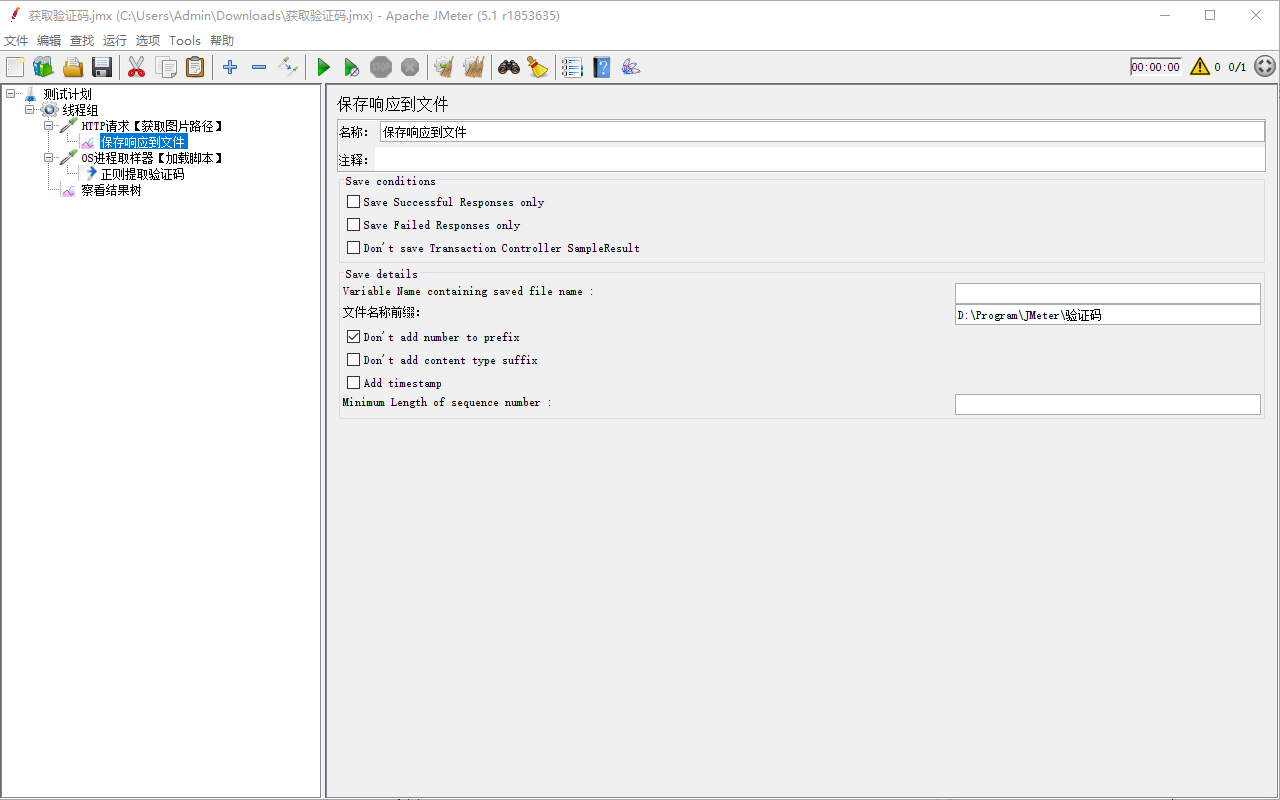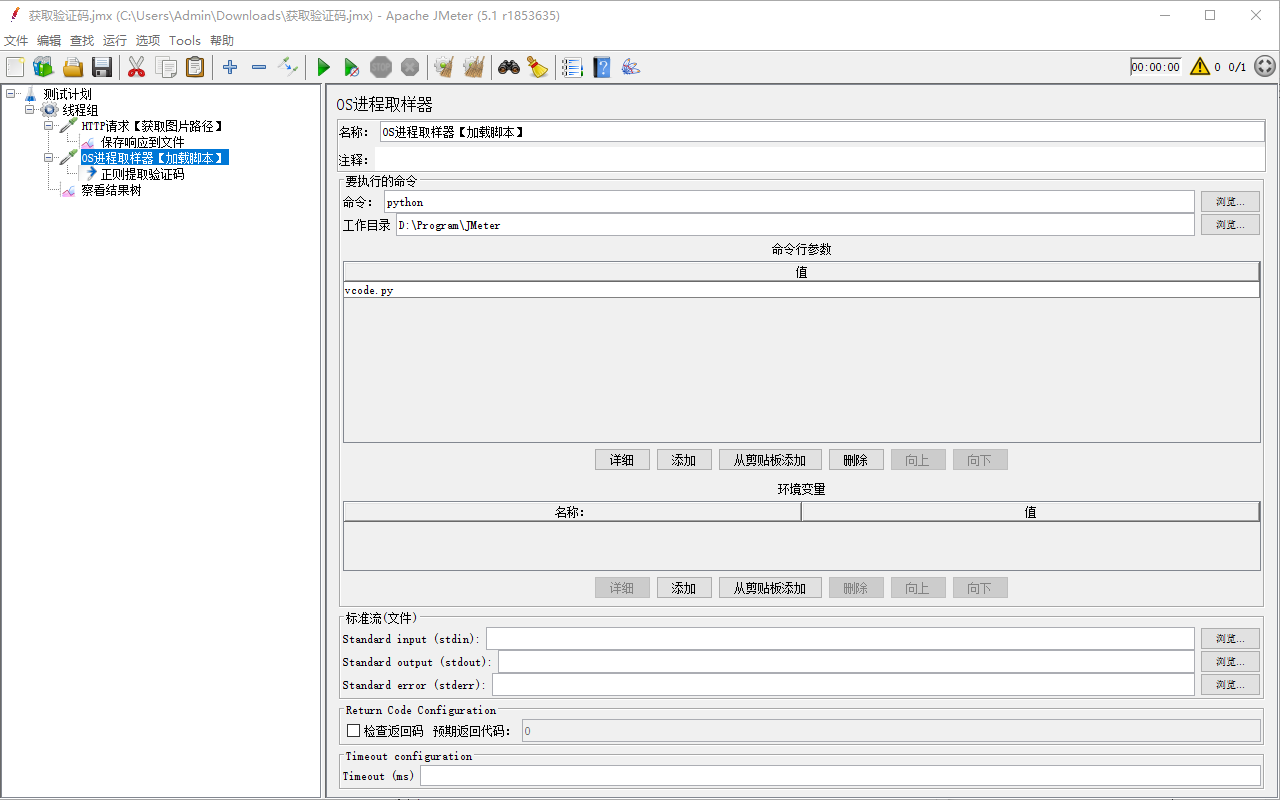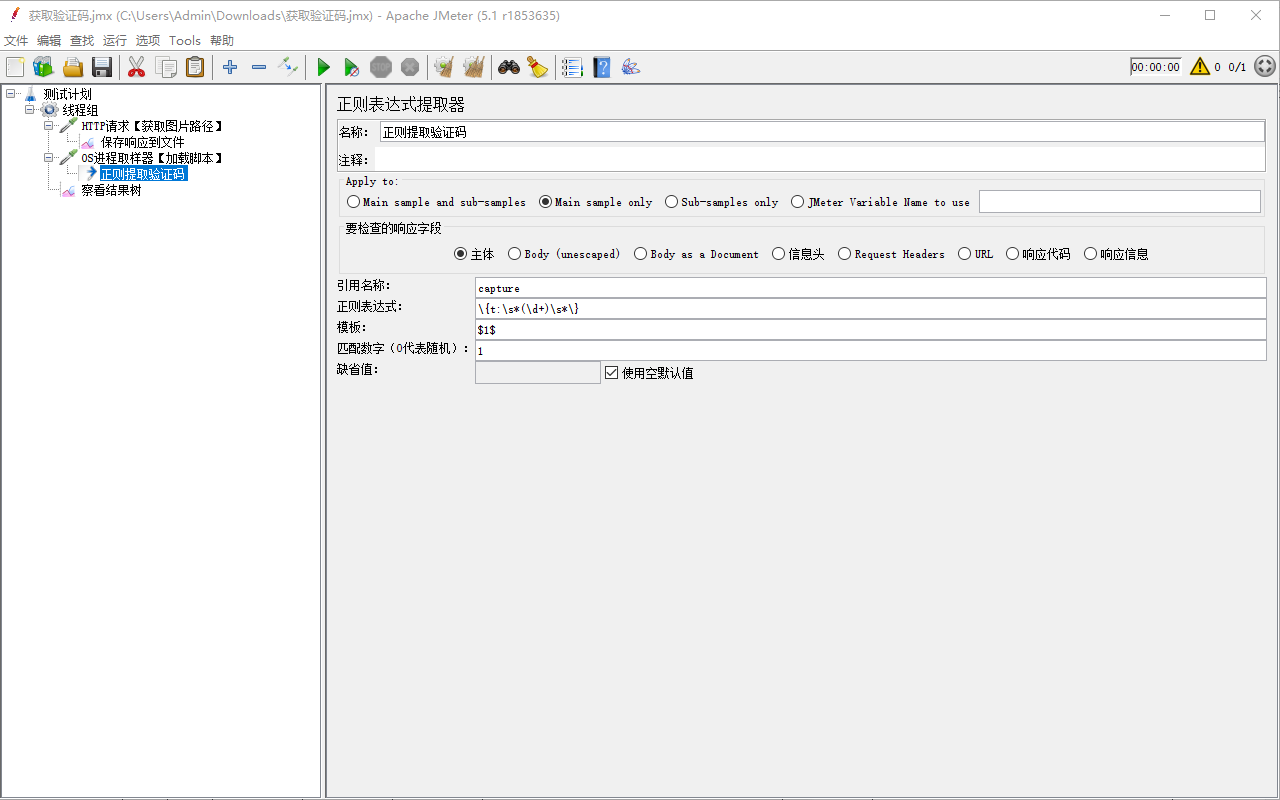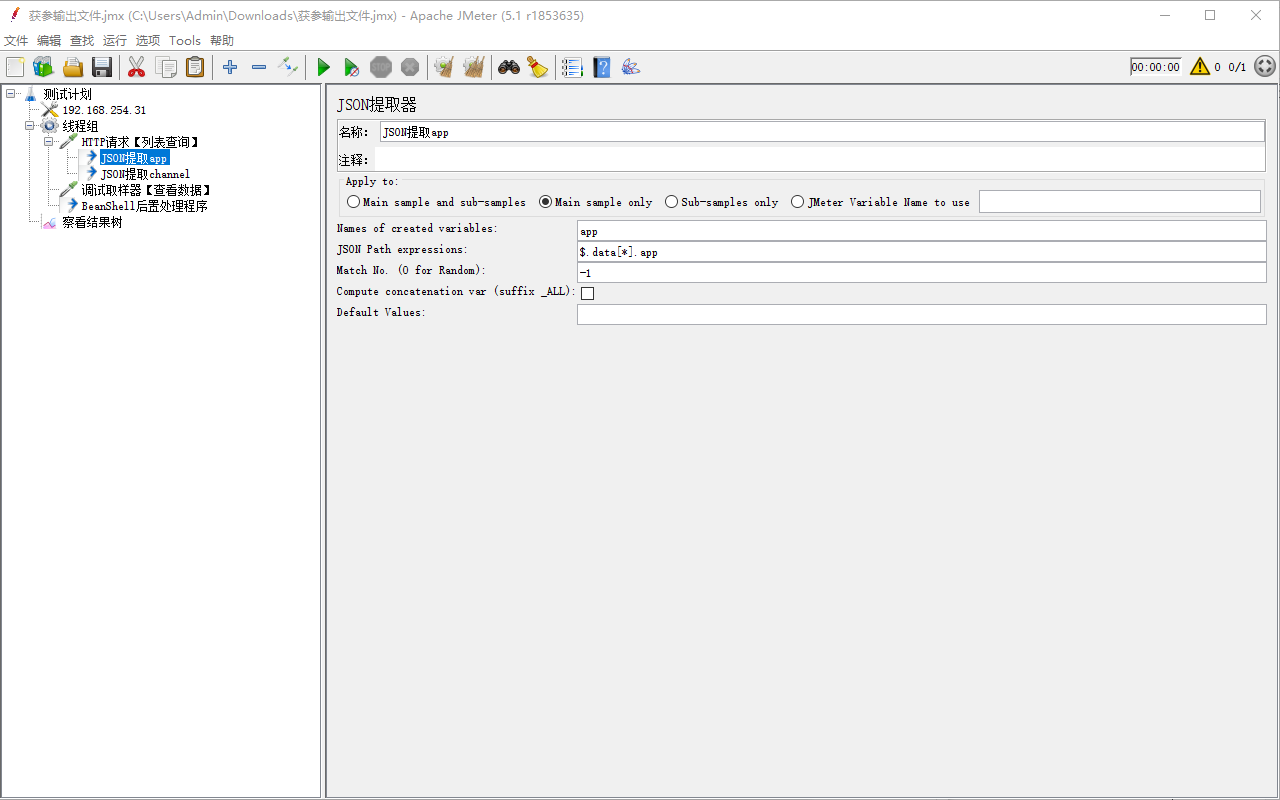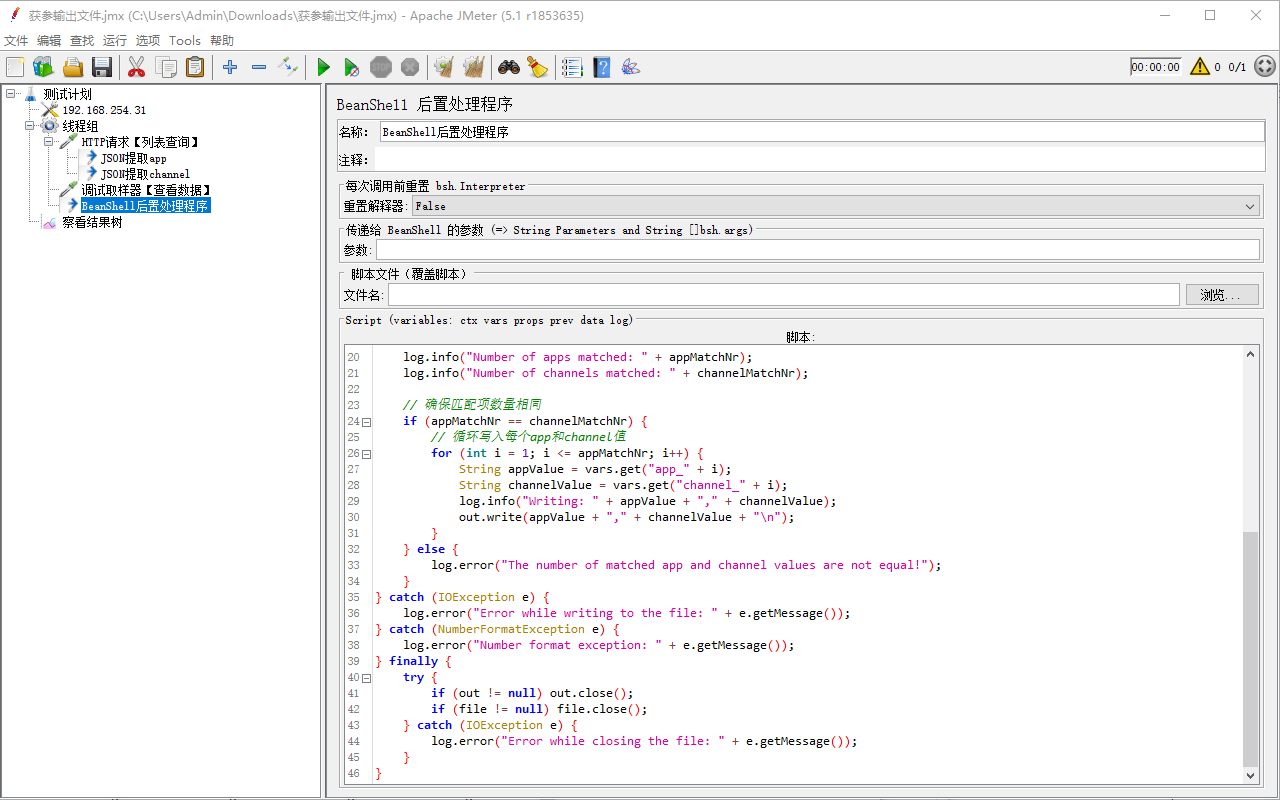🍕 通过使用脚本来执行高级操作,例如:创建复杂的测试场景、自定义请求参数、处理响应数据、编写逻辑控制和循环等。
1 获取验证码
获取验证码
(组件)HTTP请求:获取验证码图片路径并进行请求。
(组件)保存响应到文件:保存验证码图片到本地电脑。
(组件)OS进程取样器:加载Python脚本,再进行识别。
(组件)正则表达式提取器:提取脚本识别到的验证码。
验证码一般用在需要验证用户身份或防止机器人自动化操作的地方。
常见的应用场景包括:用户注册、登录、密码重置、支付验证等等。
日常测试时,一般不提倡获取验证码测试(目的不在验证用户身份)。
1-1 Python脚本文件 1 2 3 4 5 6 7 8 9 10 11 12 13 14 import ddddocrwith open ("D:\\Program\\JMeter\\验证码.jpeg" , "rb" ) as f:print ("{t:" , res.replace(" " , "" ), "}" )
1-2 保存响应到文件
保存响应到文件
验证码图片保存到指定位置,在“文件名称前缀”右侧输入保存路径。
路径包括图片名称,不需要图片后缀,JMeter默认以.jpeg格式保存。
勾选Don't add number to prefix选项,不给图片名后缀加数字编号。
1-3 OS进程加载脚本
OS进程加载脚本
命令指定为python,工作目录设置成Python脚本的路径。
命令行参数值指定Python脚本的文件名称,如vcode.py。
1-4 正则表达式提取器
正则表达式提取器
引用名称:自定义,该值即验证码的参数,后续引用使用。
正则表达式
\{t:\s*(\d+)\s*\}:匹配以{t:开头}结尾的字符串。\s*:t:后面跟着0个或多个空格,\d+至少一个数字。
模板为$1$(解析出的第一个值),匹配数字为1(第一个值)。
2 BeanShell
BeanShell
log.info()(写日志到控制台)、ctx.getProperties()(获取上下文所有的变量)。prev.getResponseDataAsString()(获取响应数据)、prev.getResponseCode()(获取响应码)。vars.get(variable_name)(获取变量的值)、vars.put(variable_name, value)(可将值保存到变量中)。props.get(property_name)(获取JMeter属性)、props.put(property_name, value)(只保存String值)。
2-1 打印信息
打印信息
线程组下添加一个BeanShell取样器,将代码放入脚本中。
菜单栏:选项->日志级别->勾选TRACE,或者DEBUG。
启动线程,点击右上角的⚠图标,在底部的日志框中查看。
1 2 3 4 5 6 7 8 9 10 11 12 13 14 15 16 17 18 "打印变量---------------------" );"信息日志---------------------" );"警告日志---------------------" );"错误日志---------------------" );"调试日志---------------------" );"获取到的JMeter属性值:" + props.get("jmeter.version" ));"jmeter.version" , "5.7" );String newVersion = props.get("jmeter.version" );"修改后的JMeter属性值:" + newVersion);
2-2 获取时间
获取时间
线程组下添加一个BeanShell取样器,将代码放入脚本中。
再添加一个调试取样器和察看结果树,启动线程查看结果。
1 2 3 4 5 6 7 8 9 10 11 12 13 14 15 16 17 18 19 20 21 22 23 24 25 26 27 28 29 30 31 32 import java.time.LocalDateTime;import java.time.format.DateTimeFormatter;LocalDateTime now = LocalDateTime.now();String formattedDateTime = now.format(DateTimeFormatter.ofPattern("yyyy-MM-dd HH:mm:ss" ));String year = now.format(DateTimeFormatter.ofPattern("yyyy" ));String month = now.format(DateTimeFormatter.ofPattern("MM" ));String day = now.format(DateTimeFormatter.ofPattern("dd" ));String hour = now.format(DateTimeFormatter.ofPattern("HH" ));String minute = now.format(DateTimeFormatter.ofPattern("mm" ));String second = now.format(DateTimeFormatter.ofPattern("ss" ));"当前时间" , formattedDateTime); "年份" , year);"月份" , month);"日期" , day);"小时" , hour);"分钟" , minute);"秒钟" , second);"当前时间:" + formattedDateTime);"年份:" + year);"月份:" + month);"日期:" + day);"小时:" + hour);"分钟:" + minute);"秒钟:" + second);
2-3 结果断言
结果断言
线程组下添加一个HTTP请求,用于请求接口。
确保该接口可正常返回响应数据,并且包含“success”字符串内容。
HTTP请求下添加一个BeanShell断言组件,将断言代码放入脚本中。
最后添加一个察看结果树,启动线程后,在察看结果树中查看结果。
1 2 3 4 5 6 7 8 9 10 String response = prev.getResponseDataAsString();if (!response.contains("success" )) {true ;"响应中未包含'Success'字符串!" ;else {false ;"响应中包含了'Success'字符串!" ;
2-4 Base64加密
Base64加密
线程组下添加一个用户定义的变量,用于存储username和password。
再添加一个BeanShell预处理程序,将BeanShell代码复制到脚本中。
最后添加一个调试取样器、一个察看结果树,启动线程后,查看结果。
1 2 3 4 5 6 7 8 9 10 11 12 13 14 15 16 17 18 19 20 21 22 23 24 25 26 27 28 29 import org.apache.commons.codec.binary.Base64;String username_var = vars.get("username" );String password_var = vars.get("password" ); "Username: " + username_var);"Password: " + password_var);if (username_var == null || password_var == null ) {"Username or Password is null!" );throw new IllegalArgumentException ("Username or Password cannot be null." );try {String username_str = Base64.encodeBase64String(username_var.getBytes("utf-8" ));String password_str = Base64.encodeBase64String(password_var.getBytes("utf-8" ));"Encoded Username: " + username_str);"Encoded Password: " + password_str);"username_enc" , username_str);"password_enc" , password_str);catch (UnsupportedEncodingException e) {"Character Encoding not supported." , e);throw new RuntimeException (e);
2-5 Base64解密
Base64解密
线程组下添加一个用户定义的变量,用于存储username和password。
再添加一个BeanShell取样器,将BeanShell代码复制粘贴到脚本中。
最后添加一个调试取样器、一个察看结果树,启动线程后,查看结果。
1 2 3 4 5 6 7 8 9 10 11 12 13 14 15 16 17 18 19 20 21 22 23 24 25 26 27 28 29 import org.apache.commons.codec.binary.Base64;String username_var = vars.get("username" );String password_var = vars.get("password" ); "Username: " + username_var);"Password: " + password_var);if (username_var == null || password_var == null ) {"Encoded Username or Password is null!" );throw new IllegalArgumentException ("Encoded Username or Password cannot be null." );try {String username_dec = new String (Base64.decodeBase64(username_var), "utf-8" );String password_dec = new String (Base64.decodeBase64(password_var), "utf-8" );"Decoded Username: " + username_dec);"Decoded Password: " + password_dec);"username_dec" , username_dec);"password_dec" , password_dec);catch (UnsupportedEncodingException e) {"Character Encoding not supported." , e);throw new RuntimeException (e);
3 获参输出文件
获参输出文件
获取接口返回的列表查询数据,然后以固定的格式输出到文件中。
思路
确保接口能正常访问并查询到数据,使用Json提取器提取想要的参数值。
一个Json提取器只能对应提取一个参数值(表达式无法一次性使用多个)。
使用调试取样器查看提取到的内容,最后使用BeanShell后置处理程序。
在BeanShell后置处理程序中编写脚本,将提取到的内容写入指定文档。
3-1 Json提取值
Json提取值
引用名称:自定义,该值即提取值的参数,后续引用使用。
Json表达式:$.data[*].app,即获取data下的所有app值。
3-2 BeanShell
BeanShell
使用BeanShell脚本只能提取到Json提取器获取到的第一个app和channel值。
需要加上调试取样器,直接获取app_matchNr和channel_matchNr的总个数。
3-3 脚本的内容 1 2 3 4 5 6 7 8 9 10 11 12 13 14 15 16 17 18 19 20 21 22 23 24 25 26 27 28 29 30 31 32 33 34 35 36 37 38 39 40 41 42 43 44 45 46 47 48 49 50 FileWriter file = null ;BufferedWriter out = null ;try {new FileWriter ("D:\\Program\\JMeter\\获参输出文件.txt" , false );new BufferedWriter (file);String appMatchNrStr = vars.get("app_matchNr" );String channelMatchNrStr = vars.get("channel_matchNr" );"app_matchNr: " + appMatchNrStr);"channel_matchNr: " + channelMatchNrStr);int appMatchNr = (null && !appMatchNrStr.isEmpty()0 ;int channelMatchNr = (null && !channelMatchNrStr.isEmpty() 0 ;"Number of apps matched: " + appMatchNr);"Number of channels matched: " + channelMatchNr);if (appMatchNr == channelMatchNr) {for (int i = 1 ; i <= appMatchNr; i++) {String appValue = vars.get("app_" + i);String channelValue = vars.get("channel_" + i);"Writing: " + appValue + "," + channelValue);"," + channelValue + "\n" );else {"The number of matched app and channel values are not equal!" );catch (IOException e) {"Error while writing to the file: " + e.getMessage());catch (NumberFormatException e) {"Number format exception: " + e.getMessage());finally {try {if (out != null ) out.close();if (file != null ) file.close();catch (IOException e) {"Error while closing the file: " + e.getMessage());
